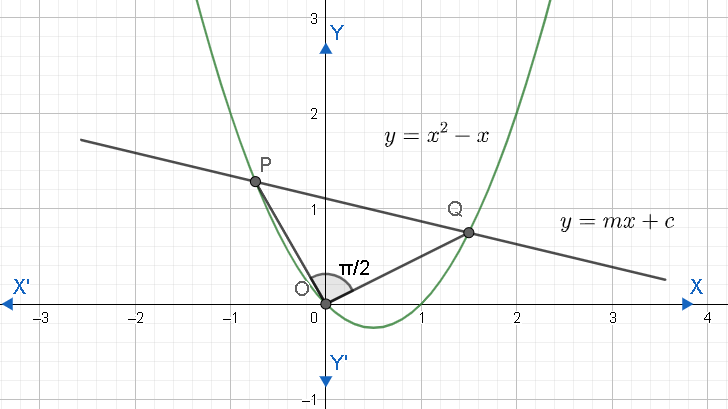Question
Question: If the variable line \(L=y-mx-c=0\left( m,c\in R\text{ and }c\ne 0 \right)\) cuts the curve \(y={{x}...
If the variable line L=y−mx−c=0(m,c∈R and c=0) cuts the curve y=x2−x at P and Q such that ∠POQ=2π , where O is the origin, then
(a) m+c−1=0
(b) m−c+1=0
(c) Line L always passes through (1,1)
(d) Line L always passes through (−1,−1)
Solution
Firstly, we have to homogenize the given parabola. For this, we will write the given line in the form 1=cy−mx and substitute this for 1 in the given curve for the terms whose degree is less than 2. Since, ∠POQ=2π , we will add the coefficient of x2 and the coefficient of y2 in the resulting equation of the previous step and equate it to 0. This step will give an equation. To check whether options c and are true, we will substitute the points given in options c and d in the given line and check whether the resultant value is equal to the equation we obtained.
Complete step by step answer:
We are given that the line L=y−mx−c=0 cuts the curve y=x2−x at P and Q such that ∠POQ=2π where O is the origin. Let us graph this situation.

We can write L=y−mx−c=0 as
y=mx+c
Let us move mx to the LHS.
⇒y−mx=c
We can write the above equation as
⇒y−mx=c×1
Let us take c to the LHS.
⇒cy−mx=1⇒1=cy−mx...(i)
We can write the given parabola y=x2−x as
y−x2+x=0
Now, let us homogenize this parabola. We can do this by rewriting the above parabola as
⇒y×1−x2+x×1=0
Let us substitute (i) in the above equation.
⇒y(cy−mx)−x2+x(cy−mx)=0
We have to apply distributive property on the LHS.
⇒cy2−ymx−x2+cxy−mx2=0
Now, we have to take the LCM and simplify.
⇒cy2−ymx−ccx2+cxy−mx2=0⇒c1(y2−ymx−cx2+xy−mx2)=0
Let us take c to the RHS.
⇒y2−ymx−cx2+xy−mx2=0×c⇒y2−ymx−cx2+xy−mx2=0
Let us take the common terms outside.
⇒(−c−m)x2+y2+xy(1−m)=0...(i)
We are given that ∠POQ=2π . Therefore, the sum of coefficient of x2 and the coefficient of y2 will be equal to 0. From (i), we can see that the coefficient of x2 is −c−m and that of y2 is 1. Therefore, we can write
⇒−c−m+1=0
Let us take –c and –m to the RHS.
⇒1=c+m
Now, we have to take 1 to the RHS.
⇒c+m−1=0...(ii)
Therefore, option (a) is correct and option b will not be satisfied.
We can check whether option c is correct or not. Let us substitute the point (1,1) in the given line L and check whether it is equal to the equation (ii).
⇒L=y−mx−c=0⇒1−m×1−c=0⇒1−m−c=0⇒m+c−1=0
Therefore, option c is correct.
Now, let us check whether option d is correct or not by substituting the point (−1,−1) in the given line L.
⇒L=y−mx−c=0⇒−1−m×−1−c=0⇒−1+m−c=0⇒−m+c+1=0
Therefore, option d is incorrect.
So, the correct answer is “Option a and c”.
Note: Students must be able to homogenize a curve. Homogenization is the process of converting the terms to a similar degree. This is the reason why we did not substitute for 1 in x2 terms of the given term. We converted the other terms to degree 2. Students have a chance of making a mistake by equating the sum of coefficients of x2 and the coefficient of y2 to 1.
